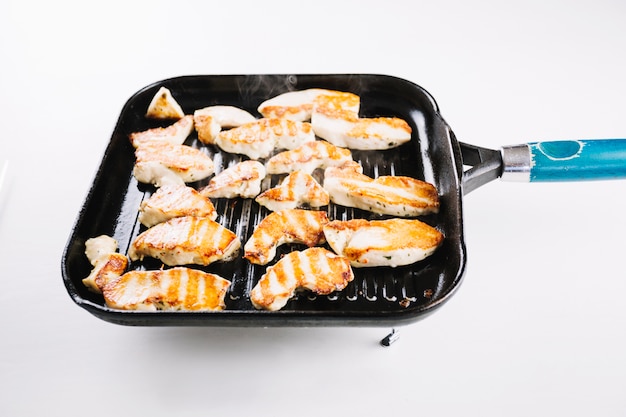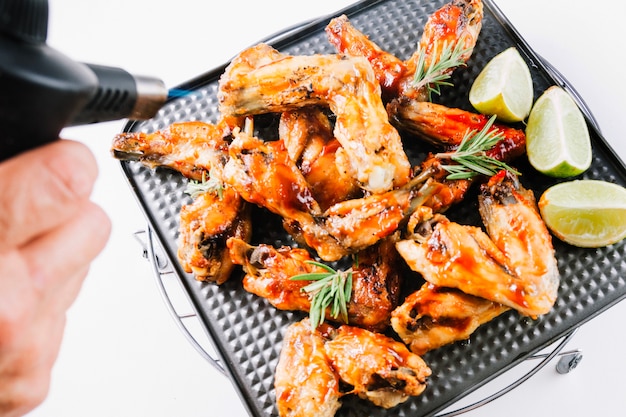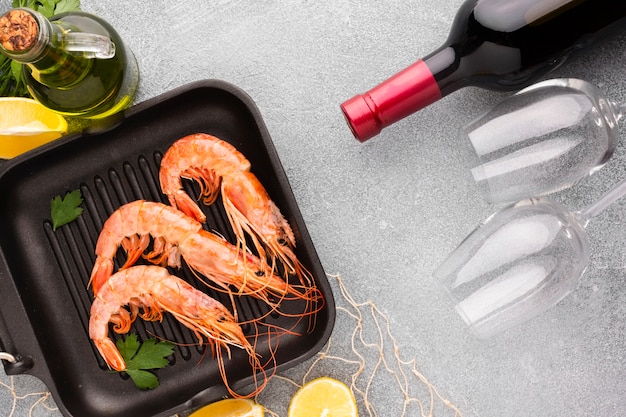Let's face it, there's nothing quite like the taste of perfectly pan-seared shrimp. It's a dish that can elevate any meal, from a quick weeknight dinner to a fancy get-together. But achieving that sweet spot, where the shrimp are cooked just right and retain their succulent texture, can be a bit of a culinary puzzle. That's where a little bit of knowledge about cooking times comes in handy.
I've been a shrimp enthusiast for as long as I can remember. I've spent countless hours in the kitchen, experimenting with different techniques, and let's be honest, making a few mistakes along the way. But over time, I've developed a system for getting that perfect sear and avoiding those unfortunate rubbery surprises. I'm here to share my tips and tricks with you so you can become a shrimp-searing pro yourself.
In this guide, we'll cover everything from the basics of choosing and prepping shrimp to picking the right pan and oil. We'll delve into the specific cooking times for different sizes of shrimp, and I'll share some of my favourite tricks and flavour combinations to make your pan-seared shrimp truly stand out. So, get ready to roll up your sleeves, grab your ingredients, and let's dive into the world of pan-seared shrimp perfection!
(Part 1) Shrimp Basics: A Primer for Pan-Searing

Before we get our hands dirty, let's start with the fundamentals. Understanding the different types and sizes of shrimp is essential for achieving those perfect pan-seared results. Think of it as laying a solid foundation for culinary success!
Shrimp Types: Navigating the Seafood Aisle
The supermarket seafood aisle can be a bit overwhelming, so let's break down the most common shrimp types you'll encounter:
- Whiteleg Shrimp: This is the workhorse of the shrimp world, readily available in most supermarkets. They have a mild, slightly sweet flavour and a firm texture, making them a versatile choice for a wide range of dishes.
- Black Tiger Shrimp: These guys are larger and more robust, offering a more pronounced flavour than their whiteleg counterparts. They're a great choice for grilling or pan-searing, where their larger size allows for a more dramatic sear and a satisfyingly firm bite.
- Pink Shrimp: These smaller shrimp boast a delicate flavour, making them ideal for salads or pasta dishes where you want a subtle seafood flavour to shine through.
shrimp sizes: Knowing Your Numbers
You'll often see shrimp labelled with numbers like 16/20, 21/25, or 26/30. These numbers represent the number of shrimp per pound, and smaller numbers indicate larger shrimp. For pan-searing, I recommend going for medium-sized shrimp (21/25 or 26/30) because they cook evenly and hold their shape well.
| Size Label | Number of Shrimp Per Pound |
|---|---|
| 16/20 | 16-20 shrimp per pound |
| 21/25 | 21-25 shrimp per pound |
| 26/30 | 26-30 shrimp per pound |
| 31/40 | 31-40 shrimp per pound |
| 41/50 | 41-50 shrimp per pound |
Remember, this is just a general guideline. If you're looking for a more dramatic sear and a meatier bite, larger shrimp might be your go-to choice. But for a balanced, consistently cooked shrimp experience, medium-sized shrimp are hard to beat.
(Part 2) Prepping Your Shrimp: A Few Steps to Success

Now, let's talk about prepping those shrimp. It's a simple but crucial step that will ensure your shrimp cook evenly and develop a beautiful sear.
1. Cleaning and Deveining: A Quick But Important Step
You'll likely find shrimp that are already cleaned and deveined at the supermarket. However, it's always a good idea to give them a quick rinse under cold water to wash away any lingering debris. If you happen to be working with uncleaned shrimp, remove the outer shell and the dark vein running along the back. This vein, called the "intestine," can be a bit gritty and unpleasant to eat.
To remove the vein, you can use a small, sharp knife or a shrimp deveining tool. If you're feeling a little more adventurous, you can even use the tip of a spoon to gently lift the vein out.
2. Patting Dry: A Must-Do for a Perfect Sear
After rinsing, pat your shrimp dry with paper towels. This is a crucial step that many people overlook. Moisture on the surface of the shrimp will steam rather than sear, leading to a less desirable texture. By patting them dry, you'll allow the shrimp to brown beautifully and develop that delicious caramelized crust.
3. Seasoning: Where the Flavour Magic Happens
Now for the fun part, seasoning! This is where you can really personalize your shrimp. A simple sprinkle of salt and pepper is always a winner, but don't be afraid to get creative and experiment with different flavour combinations.
- Garlic Powder: A classic addition that adds a pungent and aromatic touch.
- Paprika: A touch of paprika adds a warm, sweet flavour and a vibrant orange colour.
- Cayenne Pepper: If you like a little heat, a pinch of cayenne pepper will give your shrimp a fiery kick.
- Herbs: Fresh or dried herbs like thyme, rosemary, or oregano add a beautiful aroma and depth of flavour.
- Citrus Zest: A little bit of lemon or lime zest adds a bright, citrusy flavour that complements the sweetness of the shrimp.
I often like to combine a mix of spices and herbs for a complex and multi-layered flavour profile. Don't be afraid to experiment and find what works best for you!
(Part 3) Choosing the Right Pan and Oil: The Foundation for Success

The right equipment can make a world of difference in pan-searing shrimp. Choosing the right pan and oil will ensure that your shrimp cook evenly and develop a beautiful, golden brown crust.
The Pan: A Heavy-Hitter for Even Heat Distribution
For pan-searing, I highly recommend a heavy-bottomed skillet or a cast iron pan. These pans are known for their excellent heat distribution, which helps prevent hot spots that can burn your shrimp. They also retain heat well, so the pan will stay hot even after you add the shrimp, ensuring a consistent sear.
Choose a pan that's large enough to hold all your shrimp in a single layer without overcrowding them. This will allow them to cook evenly and prevent them from steaming rather than searing.
The Oil: Choosing the Right High-smoke point Oil
When it comes to oil, you want one with a high smoke point, meaning it can withstand high heat without breaking down or releasing harmful smoke. Here are a few great options:
- avocado oil: Avocado oil is a fantastic choice with a high smoke point and a neutral flavour. It won't overpower the delicate flavour of the shrimp.
- Grapeseed Oil: Grapeseed oil is another excellent option with a high smoke point and a light, slightly nutty flavour.
- Olive Oil: While extra virgin olive oil has a wonderful flavour, it has a lower smoke point than avocado or grapeseed oil. Use it sparingly for pan-searing, as it can impart a strong flavour that might mask the natural sweetness of the shrimp.
You only need a thin layer of oil in the pan, just enough to coat the bottom. Too much oil will create a greasy mess and prevent the shrimp from achieving that beautiful golden sear.
(Part 4) The Big Reveal: Cooking Times for Shrimp of All Sizes
Here we are, the heart of the matter! Understanding the optimal cooking times for different sizes of shrimp is key to achieving that perfect balance of tenderness and a satisfyingly firm bite.
Small Shrimp (16/20 or 21/25): Quick and Easy Cooking
These smaller shrimp will cook quickly, so keep a watchful eye on them.
- Over medium-high heat: About 2-3 minutes per side.
Medium Shrimp (26/30): A Little More Time for a Meatier Bite
Medium-sized shrimp will need a little more time to cook through, but they're worth the wait!
- Over medium-high heat: About 3-4 minutes per side.
Large Shrimp (31/40 or 41/50): Patience is Key for Large Shrimp
For larger shrimp, you'll need to be a little more patient, but the result is well worth the extra time.
- Over medium-high heat: About 4-5 minutes per side.
Remember, these are just general guidelines. The best way to ensure your shrimp are cooked through is to check for doneness by slicing open a shrimp. If the flesh is opaque and no longer translucent, it's ready to go. It's always better to err on the side of undercooking than overcooking, as overcooked shrimp can become rubbery and unpleasant.
(Part 5) Pan-Searing Tips and Tricks: Mastering the Art of the Sear
Now that we've covered the fundamentals, let's dive into some tips and tricks that will help you achieve that perfect pan-seared shrimp, one that's beautifully browned, juicy, and bursting with flavour.
1. Heat Matters: Get Your Pan Super Hot
The key to a great sear is a hot pan. Heat your pan over medium-high heat for about 2-3 minutes before adding the shrimp. This will help create a beautiful, crispy crust and prevent the shrimp from sticking.
2. Don't Overcrowd: Space is Key for Even Cooking
Cook your shrimp in a single layer to ensure even cooking. If you need to cook in batches, make sure to reheat the pan to the desired temperature before adding the next batch.
3. Flip Once: For a Beautiful Sear and tender shrimp
Flip your shrimp only once to achieve the best results. This will help create a beautiful sear on both sides and prevent them from becoming dry.
4. Watch for Doneness: A Visual Guide to Perfectly Cooked Shrimp
As your shrimp cook, they'll turn from translucent to pink and opaque. You can also check for doneness by slicing open a shrimp. If the flesh is white and opaque, it's ready to go.
5. Rest Before Serving: Allow the Juices to Redistribute
After cooking, let the shrimp rest for a few minutes before serving. This allows the juices to redistribute, resulting in a more tender and flavourful shrimp.
(Part 6) Beyond the Basics: Adding Flavour and Creativity
Pan-searing shrimp is a blank canvas for culinary creativity. You can experiment with different flavour combinations to create your own signature dishes.
1. Citrusy Kick: A Bright and Refreshing Touch
Add a touch of zest and juice from lemon or lime to your shrimp while cooking. You can also sprinkle chopped fresh herbs like parsley or dill after cooking for a fragrant finish.
2. Spicy Delight: Add a Little Heat to Your Shrimp
For a spicy kick, add a pinch of cayenne pepper or chili flakes to your shrimp while seasoning. Serve with a dollop of sour cream or a squeeze of lime for a tangy contrast.
3. Garlic Goodness: A Classic Flavour Boost
Sauté a few cloves of garlic in your pan before adding the shrimp for a flavour-packed base. You can also add a teaspoon of garlic powder to the seasoning.
4. Herbed Delight: Infuse Your Shrimp with Aromatic Herbs
Combine a mix of fresh or dried herbs like thyme, rosemary, or oregano for a fragrant and delicious shrimp dish.
(Part 7) Serving Up the perfect shrimp: Endless Possibilities
The fun doesn't end with cooking! There are countless ways to serve up your perfectly pan-seared shrimp. Here are just a few ideas to get your creative juices flowing:
1. Pasta Perfection: A Simple and Satisfying Meal
Toss your shrimp with your favourite pasta, a drizzle of olive oil, and a squeeze of lemon juice for a simple and satisfying meal.
2. Salad Star: A Refreshing and Healthy Option
Add your shrimp to a bed of mixed greens, cherry tomatoes, avocado, and a light vinaigrette for a refreshing and healthy option.
3. Taco Time: A Fun and Festive Dinner
Warm up tortillas and fill them with your shrimp, salsa, avocado, and your favourite toppings for a tasty taco fiesta.
4. Shrimp Skewers: A Colourful and Flavourful Dish
Thread your shrimp onto skewers with bell peppers, onions, and pineapple for a colourful and flavourful dish.
5. Seafood Platter: A Luxurious and Impressively Diverse Feast
Combine your pan-seared shrimp with other seafood delights like grilled fish, scallops, or mussels for a luxurious seafood platter.
(Part 8) FAQs: Your Burning Shrimp Questions Answered
Let's tackle some of the most common questions about pan-searing shrimp.
1. Can I freeze shrimp before pan-searing?
Yes, you can freeze shrimp! It's best to freeze them in a single layer on a baking sheet to prevent them from sticking together. Once frozen, transfer them to a freezer-safe bag. When you're ready to use them, thaw them in the refrigerator overnight or in a bowl of cold water.
2. How can I tell if shrimp is done?
Here are a few ways to determine if your shrimp are cooked through:
- Pink and Opaque: The shrimp will turn from translucent to a firm, pink colour when cooked.
- Firm Texture: The shrimp should be firm and springy to the touch.
- internal temperature: Use a meat thermometer to check the internal temperature. It should be at least 145°F (63°C) for safe consumption.
3. What if my shrimp is overcooked?
Overcooked shrimp will become rubbery and tough. If you notice your shrimp are overcooked, try to salvage them by adding a little bit of liquid, like broth or wine, to the pan and simmering them for a minute or two to soften them up.
4. Can I add seasonings to my shrimp after cooking?
Absolutely! Adding seasonings after cooking allows the flavours to shine through without being masked by the heat. Try sprinkling on chopped herbs, lemon zest, or a squeeze of lime juice for a bright and refreshing finish.
5. How long can I keep cooked shrimp in the refrigerator?
Cooked shrimp can be stored in the refrigerator for 3-4 days. It's best to keep them in an airtight container and refrigerate them as soon as they're cooked.
And there you have it! I hope this comprehensive guide has equipped you with all the knowledge and confidence you need to become a shrimp-searing superstar. So, grab your pan, get your shrimp ready, and let's get cooking!
Remember, cooking is all about experimentation and having fun. Don't be afraid to try new things and create your own delicious shrimp dishes. Happy cooking!
Everyone is watching

Corn on the Cob: The Ultimate Guide to Perfectly Cooked Ears
Healthy MealsAh, corn on the cob. Just the name evokes images of sunny days, barbecues, and that sweet, juicy flavour that ...

Perfect Pork Roast Oven Cooking Time: A Guide to Delicious Results
Healthy MealsThere's something truly satisfying about a perfectly roasted pork. The aroma alone is enough to make your mout...

Scallops: The Ultimate Guide to Perfect Cooking
Healthy MealsAh, scallops. Those delicate, sweet, and utterly delicious morsels of the sea. They hold a special place in my...

Ham Cooking Time: How Long to Bake, Smoke, or Boil a Delicious Ham
Healthy MealsAh, ham. It's a classic, isn't it? A real crowd-pleaser, especially around holidays. And when done right, it'...

Spaghetti Squash: The Ultimate Guide to Cooking and Serving
Healthy MealsRemember that time you saw spaghetti squash at the supermarket, looking all bumpy and strange, and thought, "W...
